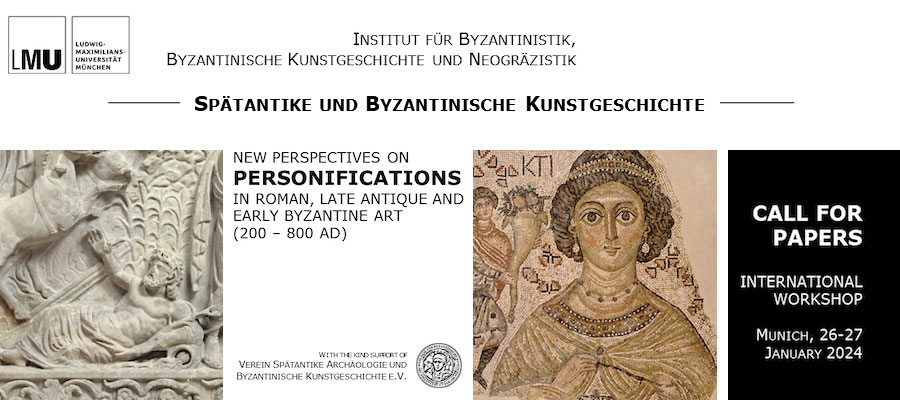New Perspectives on Personifications in Roman, Late Antique and Early Byzantine Art (200–800 AD), Munich, January 26–27, 2024
Paper proposals are invited for the international workshop “New Perspectives on Personifications in Roman, Late Antique and Early Byzantine Art (200-800 AD)” with keynote lecture by Professor Emma Stafford, University of Leeds, School of Languages, Cultures and Societies.
Personifications are some of the most geographically and chronologically widespread phenomena in Art History. From monumental sculpture or floor mosaics to textiles, coins or everyday objects, personifications were represented in all visual media to express and communicate a variety of different ideas, such as natural phenomena, months, seasons or geographical regions, personal qualities or intangible abstractions. While some are easily identifiable via specific attributes, others can only be recognized through name labels; some occur as isolated figures, others as active participants in complex scenes; some exist in countless examples, others survive in a singular image. They may have counterparts in contemporary written sources, or may be purely visual inventions. In addition, a single personification can carry multivalent meanings, which may allow for several layers of interpretation. Over time their ontological status, functions and meanings have undergone various changes. A significant period of transformation is the transition from the ancient to the mediaeval world. While personifications were seen as numinous figures in ancient Mediterranean societies, they may have been rather symbolic or allegorical in mediaeval visual cultures.
The aim of this workshop is to explore the formal patterns, roles and meanings, continuities and innovations in the depictions of personifications of this period to better understand their functions, their relationship to one another and to other iconographic tools, as well as the changes that occur between the second and ninth centuries in the Mediterranean world.
The organizers invite proposals for individual papers from the fields of classics, archaeology, art history, visual studies, numismatics, sigillography and related fields addressing especially, but not exclusively, the following topics:
- New research on individual personifications in all Roman, Late Antique and Byzantine visual media (sculpture, painting, mosaic, coins, seals, textiles, book illumination, jewellery, everyday and/or luxury objects, etc.)
- Methodological and theoretical approaches towards personifications (ontology, polysemy, etc.)
- Reflections on the relationship between text and image in the analysis of personifications
- Functional comparisons between different formats (stand-alone personifications, personifications in groups and/or narrative scenes)
- Chronological and geographical comparisons and iconographical developments in the depictions of personifications
- Relationship between the pictorial representation of personifications and their spatial and/or cultural context
- Relationship between personifications and the patrons, recipients and viewers of objects and works of art that include them
The workshop will take place in-person at Ludwig-Maximilians-Universität München and the Museum für Abgüsse Klassischer Bildwerke in Munich on Friday and Saturday, 26-27 January 2024 and will be held in English.
The workshop is organized by Institut für Byzantinistik, Byzantinische Kunstgeschichte und Neogräzistik, Ludwig-Maximilians-Universität München with the kind support of Spätantike Archäologie und Byzantinische Kunstgeschichte e.V.
Organizers
Charles Wastiau, Université de Liège & Rheinische Friedrich-Wilhelms-Universität Bonn
Prolet Decheva, University College Dublin & Ludwig-Maximilians-Universität München
